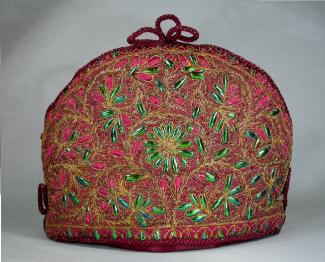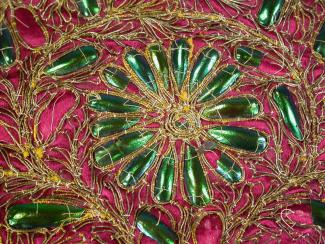This beetle wing tea-cosy is well designed. The pattern is the same on both sides- a series of flower heads and leaves outlined in gilt-wrapped yellow thread, and surrounded by symmetrical, swirling arabesques. The contrasting colour of green beetle-wings against a rich ground of ruby wine coloured silk satin – a hallmark colour of the 1880s in Britain - makes a sparkling feast for the eye. The application of the couched thread also adds to the opulent look of the beetle-wing-encrusted cloth. A length of ruby coloured cording defines the outer tea-cosy shape, and cleverly loops at the top to form the handle. The beetle-wings and gilt wrapped thread are lightweight so that the tea-cosy weighs only a little more than a plain silk satin one. We do not have access to the interior of the tea-cosy to analyse the wadding, but certainly eider duck down from Russia was very popular for quilted petticoats of this period. The size and form of the tea-cosy is entirely consistent with other examples of beaded, embroidered and painted European tea-cosies of the period c.1867-90. This beetle-wing tea-cosy is in remarkable condition. As so often when an object is not merely functional but also highly decorative, it was perhaps put away for best, and then thought too precious to actually use, merely adorning a sideboard for high tea on occasion. There is evidence of display, in the slight fading of the silk, and friction causing broken and missing beetle-wings. There is little evidence of use, however, as the interior lined with the same silk satin is immaculate. It has earned its place as a real museum piece.
Such items were often made in India, but were used by Europeans seeking something unusual and exotic. The beetle-wings have an iridescence that is fascinating, as they catch the light, natural or artificial, with the effect of a highly polished reflective stone or glass. Indeed they can be mistaken for gemstones or glass pastes of emerald or sapphire from a distance. Early examples would originally have been seen by candle light or gas light, presenting quite an intriguing spectacle.
Tea-cosies have, as their name implies, a practical function in keeping tea warm, but their mass consumption in the Victorian period, and increasingly extravagant decoration, is testament to the sometimes rather prudish covering up-of all manner of objects from mantle-shelves to piano legs in that era. Tea-cosies were also perfect foils for demonstrating a housewife’s skills with the needle, and patterns for tea-cosies embroidered in Berlin wool-work, and beading, and silks and velvets painted, and decorated with pokerwork, abounded, from the later 1860s. The beetle-wings used in embroidery are the modified fore-wings (elytra) of beetles (Coleoptera) and mostly come from members of the family Buprestidae, often know as Jewel Beetles. Each beetle has two hard elytra that protect the delicate, membranous hind-wings which are folded away beneath the elytra when they are not being used for flying. One of the most frequently used beetle-wing comes from the species Sternocera aequisignata Saunders. This jewel beetle is found in Northern India, Burma and Thailand, and is apparently fairly common where it occurs.
The beetle-wings for this tea-cosy have clearly been cut to shape where necessary, to give a more symmetrical leaf form. They were then pierced with a needle and sewn to the silk satin with cotton thread, to secure them at each end.
It seems likely from the details of provenance we can ascertain, that this tea-cosy was worked in India, by male embroiderers, to a European tea-cosy pattern for expatriate use in India initially. However it was clearly possible to acquire the beetle-wings in England by the mid Victorian era, too




